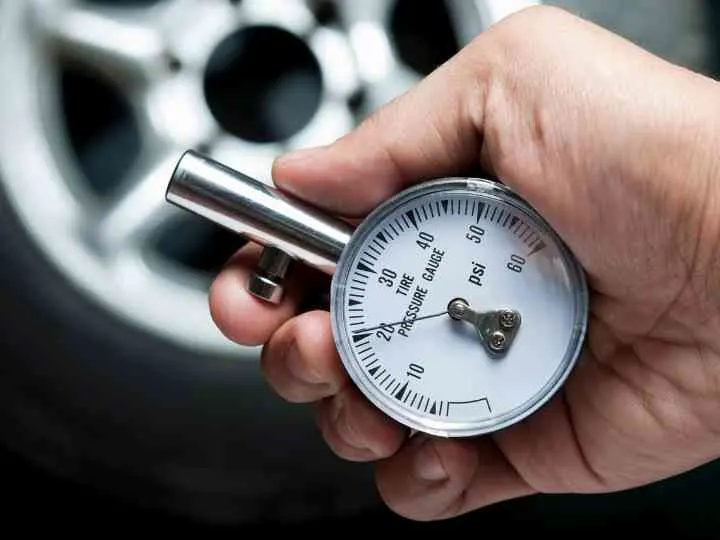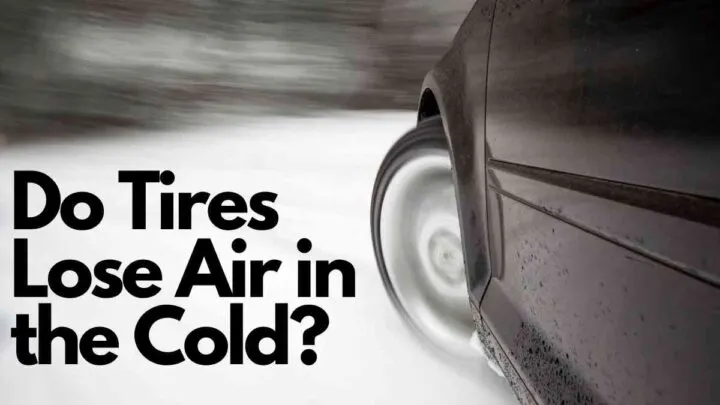We don’t always think about how the weather affects our vehicles.
But, that doesn’t mean it’s not doing anything to them.
Your tires regularly change pressure depending on the temperature, deflating in the cold.
A tire loses approximately 2 PSI for every 10-degree Fahrenheit drop in temperature. This is due to Guy-Lussac’s Law, which states that temperature and pressure have a directly proportional relationship for a fixed volume.
Thankfully, your car probably tells you when there’s a tire that’s got low pressure, thanks to TPMS. A tire pressure monitoring system notifies you if tires lost too much pressure.
Pay attention to your TPMS and refill your tires when they’re low. That’s going to prolong their lifespan, and it’ll improve your fuel economy as well.
Why Do Tires Lose Air in the Cold?
We’ve all heard the rumors that tires lose air in the cold.
It turns out the rumors were accurate when they described how tires react to the weather. If it’s cold outside, your tires probably lost some air pressure.
That’s because air’s density changes according to the temperature. Hot weather expands air, making it less dense.
The air gets denser once the temperature begins to drop.
Dense air has an easier time getting out of the tire.
Plus, it’s going to produce less pressure even if it’s in the tire. Pressure is proportional to a system’s temperature as long as it’s a closed network.
Dropping the temperature automatically causes a drop in pressure, assuming nothing else changes.
Your tires might lose enough pressure to make a difference. That’s why your TPMS notifies you there’s been a pressure drop.
Sometimes, your TPMS will even tell you which tires have lost pressure. If yours does that, it’s easy to refill the tire.
Just put some air in the one that’s lost the most pressure. Once you’ve refilled it, your notification should disappear.
That’s when it’s safe for you to start driving again. Your tires might regain pressure after you’ve driven on them for a little bit.
Driving creates a lot of friction, increasing their temperature. This increase in temperature makes the air pressure increase, too.
How Can You Stop Your Tires From Losing Air?
You probably don’t want to refill your tires each morning during the winter.
There are a few things you can do to prevent them from losing air when it’s cold outside.
Don’t let your tires go too long without replacing them.
The longer it’s been since you’ve replaced them, the more air they’ll lose. Tires aren’t meant to last forever, so they’ll leak more as they age.
We can’t do anything about the pressure dropping due to the temp. However, we can prevent your tires from losing more pressure by making sure they’re sealed.
If you’ve had a puncture, make sure it’s got a seal.
Sealing punctures can stop you from needing a replacement if you’ve got a flat tire.
You should also look at how much tread they have, too.
If they’ve lost too much tread, you’ll need to replace them anyway.
Your tires should always have at least 3/32 inches of tread on their surface. Less than that would mean you’re at risk of hydroplaning on wet roads.

What Should You Do if Your Tires Lose Air?
Make sure you’re testing their air pressure frequently when it’s cold outside.
Since they’re more likely to lose pressure, it’s important to test them. That’s how you’ll know if they’ve lost too much pressure to drive on them safely.
We’d suggest getting a tire pressure gauge that’s easy to keep in the car.
Take it with you everywhere you go while it’s wintertime. If one of your tires looks like it’s low, test its pressure.
Just screw the tire pressure gauge onto the tire’s inlet valve. It’ll let you know within a few seconds how much pressure the tire has.
If it’s low, you can refill them using a portable air pump. They’ve got them at most auto parts stores, so it’s not hard to find them.
Most of the time, you’re able to hook them up to your car’s AC converter.
Using a portable air pump can make it a lot easier to refill your tires if they’ve lost too much pressure. You can also look at your tires before getting in the car to see if they’re looking low.
When they’re low on pressure, you’ll notice a sag near the bottom of the tires. They’re not going to support the car as much if their pressure is too low.
You might even notice the car is sitting on the rim while it’s parked.
What Happens if You Don’t Refill Low Tires?
Refilling your tires is something you’ve got to do if they’re low. Otherwise, you’ll tear them apart way quicker.
Low tires create a lot of friction when you’re moving, ripping the rubber. Putting more air into them should prevent anything from breaking.
But, if you drive on them, you might need replacements.
Another reason you should refill flat tires is how they affect your fuel economy. Flat tires don’t roll well, decreasing your efficiency.
If you’ve got full tires, they’ll use way less fuel to take you the same distance.
So, you should make sure your tires have plenty of air before driving on them. They’ll last longer if they’re full!
Plus, you’ll spend less on fuel if they’ve been fully pressurized.
How Much Pressure Should My Tires Have?
It’s impossible to say how much pressure a tire should have without looking at its manual. Usually, you can find their info in the back of your car’s manual.
Each tire has a specific pressure where they’re most efficient. Most of the time, it’s somewhere between 30 PSI and 40 PSI.
However, not all tires use the same pressure levels. That’s why it’s so important to check your manual if you’re refilling them.
Putting too much air in them could make them likely to pop. At the same time, too little air can also cause problems.
Filling them up with an air pump isn’t too hard, though. They’ve built air pumps that have pressure gauges on them.
So, you can see how much pressure each tire has while you’re refilling them. Once they’ve reached full pressure, stop filling them up with more air.
Exceeding their recommended pressure can shorten their lifespan by quite a bit.
